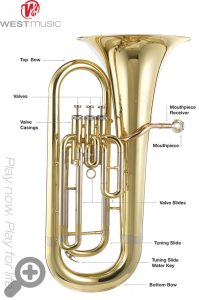Congratulations on choosing to play the baritone or euphonium horn. While not quite as well-known as other instruments in the band, these large brass instruments pack a powerful musical punch. Whether you are new to music, new to the baritone/euphonium, or a parent of a music student, you will want to know these basics soon after receiving your instrument.
Tubas, Baritones, and Euphoniums – Oh My!
While many people confuse baritones and euphoniums with tubas, they are very different instruments. Tubas are much larger and create lower sounds then the baritone or euphonium. In fact, tubas are the lowest pitched instrument in brass family. Baritones and euphoniums, on the other hand, are smaller and more manageable. That makes them a much better choice for beginners.
Baritones and euphoniums are nearly identical in design. The main difference is the tubing, or bore size. The euphonium is conical; the tubing gradually gets bigger from the mouthpiece to the bell. The baritone is cylindrical; it maintains a consistent bore size throughout the major portion of the instrument. The baritone is also smaller and produces a brighter sound than the more solid, brassy timbre of the euphonium.
Parts of the Baritone/Euphonium
 Click on the image to zoom in.
Click on the image to zoom in.
While at first, it seems like a lot to learn, memorizing the different parts of the baritone/euphonium is easy! Below is a clip from Alfred Music going over the different parts of the instrument. Alfred Music is the publisher of the popular Sound Innovations method book series.
[su_youtube url=”https://youtu.be/YfIYi-sXah8″ width=”360″ height=”240″]
Assembling Your Instrument
While large, the baritone/euphonium is delicate and should be handled with care. Follow these instructions or the instructions given to you by your music director to prevent damaging the instrument.
- Place the case down on its side.
- Open the latches and hold the case open.
- Use both hands to pick up the instrument.
- Carefully place the mouthpiece in the mouth receiver (also called the lead pipe).
- Gently twist the mouth to the right to tighten it, being careful not to over tighten.
Putting It All Away
- Remove the mouthpiece by gently twisting it to the left and place it in the mouthpiece holder.
- If your mouthpiece gets stuck, seek help from your teacher or from West Music’s repair team. We have a special tool to remove a stuck mouthpiece that will not damage the instrument.
- Press the water keys and gently blow air through the mouthpiece receiver to remove excess condensation on to a soft cloth.
- Wipe off the outside with a soft cloth.
- Carefully place the instrument in the case and close all the latches.
- Store only your instrument and its accessories in the case. Sheet music, folders, and other objects may bend the keys and damage the instrument.
Related Articles
- How to Hold Your Brass Instrument
- Brass Wind Care Tips
- 7 Tips for Practicing
- Practice Tips for Young Musicians
Have questions? Need advice? West Music is here for you! Give our school band experts a call at 800-373-2000.
Adapted from Alfred Music’s Sound Innovations for Concert Band 1: Baritone/Euphonium.
Special thanks to our partners at Alfred Music for providing us smartmusic® videos and additional materials.




